Visualizing the Intellectual Structure and Evolution of Intelligent Transportation Systems: A Systematic Analysis of Research Themes and Trends
Abstract
1. Introduction
2. Methodology and Data set
Data set
3. Performance Bibliometric Analysis of the Intelligent Transportation Systems
3.1. Performance and Impact Indicators
3.2. Most Productive and Most Cited Authors, Organizations, Geographic Distribution of Publications and Research Areas
3.3. Citations Classics
4. Science Mapping Analysis of Intelligent Transportation Systems
4.1. Analysis of the Themes and Content of the Publications
4.2. Intelligent Transportation System Research Evolution Map
5. Conclusions
Author Contributions
Funding
Acknowledgments
Conflicts of Interest
Appendix A
| Rank | Title (Author(s), Year) | Source | Citations (Avg) |
|---|---|---|---|
| 1 | Traffic Flow Prediction With Big Data: A Deep Learning Approach (Lv, Y.; Duan, Y.; Kang, W.; Li, Z.; Wang, F. Y. 2015) | IEEE Transactions on Intelligent Transportation Systems | 819 (136.50) |
| 2 | Review of road traffic control strategies (Papageorgiou, M.; Diakaki, C.; Dinopoulou, V.; Kotsialos, A.; Wang, Y. B., 2003) | Proceedings of the IEEE | 525 (29.17) |
| 3 | Data-Driven Intelligent Transportation Systems: A Survey (Zhang, J.; Wang, F. Y.; Wang, K.; Lin, W. H.; Xu, X.; Chen, C., 2011) | IEEE Transactions on Intelligent Transportation Systems | 501 (50.10) |
| 4 | Intelligent Transportation Systems–Enabling Technologies (Garcia-Ortiz, A.; Amin, S. M.; Wootton, J. R., 1995) | Mathematical and Computer Modelling | 469 (0.54) |
| 5 | Modeling and forecasting vehicular traffic flow as a seasonal ARIMA process: Theoretical basis and empirical results (Williams, B. M.; Hoel, L. A., 2003) | Journal of Transportation Engineering | 446 (24.78) |
| 6 | Travel-time prediction with support vector regression (Wu, C. H.; Ho, J. M.; Lee, D. T., 2004) | IEEE Transactions on Intelligent Transportation Systems | 434 (25.53) |
| 7 | Connected Vehicles: Solutions and Challenges (Lu, N.; Cheng, N.; Zhang, N.; Shen, X.; Mark, J. W., 2014) | IEEE Internet of Things Journal | 405 (57.86) |
| 8 | Vehicular Communication Systems: Enabling Technologies, Applications, and Future Outlook on Intelligent Transportation (Papadimitratos, P.; de La Fortelle, A.; Evenssen, K.; Brignolo, R.; Cosenza, S., 2009) | IEEE Communications Magazine | 402 (33.50) |
| 9 | Smart card data use in public transit: A literature review (Pelletier, M. P.; Trepanier, M.; Morency, C., 2011) | Transportation Research. Part C-Emerging Technologies | 378 (37.80) |
| 10 | A multiagent approach to autonomous intersection management (Dresner, K.; Stone, P., 2008) | Journal of Artificial Intelligence Research | 377 (29.00) |
| 11 | Short-term traffic forecasting: Where we are and where we’re going (Vlahogianni, Eleni I.; Karlaftis, Matthew G.; Golias, John C., 2014) | Transportation Research. Part C-Emerging Technologies | 368 (52.57) |
| 12 | Parallel Control and Management for Intelligent Transportation Systems: Concepts, Architectures, and Applications (Wang, F. Y., 2010) | IEEE Transactions on Intelligent Transportation Systems | 365 (33.18) |
| 13 | Estimating vehicle fuel consumption and emissions based on instantaneous speed and acceleration levels (Ahn, K.; Rakha, H.; Trani, A.; Van Aerde, M., 2002) | Journal of Transportation Engineering | 357 (18.79) |
| 14 | A survey on vehicular cloud computing (Whaiduzzaman, M. D.; Sookhak, M.; Gani, A.; Buyya, R., 2014) | Journal of Network and Computer Applications | 353 (50.43) |
| 15 | Optimized and meta-optimized neural networks for short-term traffic flow prediction: A genetic approach (Vlahogianni, E. I.; Karlaftis, M. G.; Golias, J. C., 2005) | Transportation Research. Part C-Emerging Technologies | 331 (20.69) |
| 16 | Real-Time Urban Monitoring Using Cell Phones: A Case Study in Rome (Calabrese, F.; Colonna, M.; Lovisolo, P.; Parata, D.; Ratti, C., 2011) | IEEE Transactions on Intelligent Transportation Systems | 311 (31.10) |
| 17 | Deep Architecture for Traffic Flow Prediction: Deep Belief Networks With Multitask Learning (Huang, W.; Song, G.; Hong, H.; Xie, K., 2014) | IEEE Transactions on Intelligent Transportation Systems | 311 (44.43) |
| 18 | A license plate-recognition algorithm for intelligent transportation system applications (Anagnostopoulos, C. N. E.; Anagnostopoulos, I. E.; Loumos, V.; Kayafas, E., 2006) | IEEE Transactions on Intelligent Transportation Systems | 302 (20.13) |
| 19 | Traffic flow forecasting: Comparison of modeling approaches (Smith, B. L.; Demetsky, M. J., 1997) | Journal of Transportation Engineering—ASCE | 299 (12.46) |
| 20 | Cooperative Adaptive Cruise Control in Real Traffic Situations (Milanes, V.; Shladover, S. E.; Spring, J.; Nowakowski, C.; Kawazoe, H.; Nakamura, M., 2014) | IEEE Transactions on Intelligent Transportation Systems | 294 (42.00) |
| 21 | Stabilization effect of traffic flow in an extended car-following model based on an intelligent transportation system application (Ge, H. X.; Dai, S. Q.; Dong, L. Y.; Xue, Y., 2004) | Physical Review E | 285 (16.76) |
| 22 | Short-term traffic forecasting: Overview of objectives and methods (Vlahogianni, E. I.; Golias, J. C.; Karlaftis, M. G., 2004) | Transport Reviews | 285 (16.76) |
| 23 | Challenges of intervehicle ad hoc networks (Blum, J. J.; Eskandarian, A.; Hoffman, L. J., 2004) | IEEE Transactions on Intelligent Transportation Systems | 279 (16.41) |
| 24 | Robust lane detection and tracking in challenging scenarios (Kim, Z. W., 2008) | IEEE Transactions on Intelligent Transportation Systems | 276 (21.23) |
| 25 | A multivariate state space approach for urban traffic flow modeling and prediction (Stathopoulos, A.; Karlaftis, M. G., 2003) | Transportation Research. Part C-Emerging Technologies | 274 (15.22) |
| 26 | A Review of the Applications of Agent Technology in Traffic and Transportation Systems (Chen, B.; Cheng, H. H., 2010) | IEEE Transactions on Intelligent Transportation Systems | 269 (24.45) |
| 27 | Development and Evaluation of a Cooperative Vehicle Intersection Control Algorithm Under the Connected Vehicles Environment (Lee, J.; Park, B., 2012) | IEEE Transactions on Intelligent Transportation Systems | 264 (29.33) |
| 28 | WAVE: A Tutorial (Uzcategui, R. A.; Acosta-Marum, G., 2009) | IEEE Communications Magazine | 250 (20.83) |
| 29 | Smart Antennas in Intelligent Transportation Systems (Li, M.; Wang, B.; Lu, Y.; Zhou, M. T.; Chen, I. M., 2010) | Wireless Technologies in Intelligent Transportation Systems | 250 (22.73) |
| 30 | Vehicular Ad hoc Networks (VANETs): Challenges and perspectives (Yousefi, S.; Mousavi, M. S.; Fathy, M., 2006) | 2006 6th International Conference on ITS Telecommunications. Proceedings | 246 (16.40) |
| 31 | Energy and emissions impacts of a freeway-based dynamic eco-driving system (Barth, M.; Boriboonsomsin, K., 2009) | Transportation Research. Part D-Transport and Environment | 243 (20.25) |
| 32 | Online-SVR for short-term traffic flow prediction under typical and atypical traffic conditions (Castro-Neto, M.; Jeong, Y. S.; Jeong, M. K.; Han, L. D., 2009) | Expert Systems with Applications | 242 (20.17) |
| 33 | Vision-based intelligent vehicles: State of the art and perspectives (Bertozzi, M.; Broggi, A.; Fascioli, A., 2000) | Robotics and Autonomous Systems | 238 (11.33) |
| 34 | LSTM network: a deep learning approach for short-term traffic forecast (Zhao, Z.; Chen, W.; Wu, X.; Chen, P. C. Y.; Liu, J., 2017) | IET Intelligent Transport Systems | 238 (59.50) |
| 35 | Developing Vehicular Data Cloud Services in the IoT Environment (He, W.; Yan, G.; Xu, Li D., 2014) | IEEE Transactions on Industrial Informatics | 230 (32.86) |
| 36 | A Survey of Inter-Vehicle Communication Protocols and Their Applications (Willke, T. L.; Tientrakool, P.; Maxemchuk, N. F., 2009) | IEEE Communications Surveys and Tutorials | 228 (19.00) |
| 37 | Last mile distribution in humanitarian relief (Balcik, B.; Beamon, B. M.; Smilowitz, K., 2008) | Journal of Intelligent Transportation Systems | 221 (17.00) |
| 38 | Dynamic wavelet neural network model for traffic flow forecasting (Jiang, X. M.; Adeli, H., 2005) | Journal of Transportation Engineering | 219 (13.69) |
| 39 | Short-term freeway traffic flow prediction: Bayesian combined neural network approach (Zheng, W. Z.; Lee, D. H.; Shi, Q. X., 2006) | Journal of Transportation Engineering | 218 (14.53) |
| 40 | Trip-Based Optimal Power Management of Plug-in Hybrid Electric Vehicles (Gong, Q.; Li, Y.; Peng, Z. R., 2008) | IEEE Transactions on Vehicular Technology | 217 (16.69) |
| 41 | Traffic sign recognition and analysis for intelligent vehicles (de la Escalera, A.; Armingol, J. M.; Mata, M., 2003) | Image And Vision Computing | 216 (12.00) |
| 42 | Toward Cloud-Based Vehicular Networks with Efficient Resource Management (Yu, R.; Zhang, Y.; Gjessing, S.; Xia, W.; Yang, K., 2013) | IEEE Network | 212 (26.50) |
| 43 | D2D for Intelligent Transportation Systems: A Feasibility Study (Cheng, X.; Yang, L.; Shen, X., 2015) | IEEE Transactions on Intelligent Transportation Systems | 211 (35.17) |
| 44 | Heterogeneous Vehicular Networking: A Survey on Architecture, Challenges, and Solutions (Zheng, K.; Zheng, Q.; Chatzimisios, P.; Xiang, W.; Zhou, Y., 2015) | IEEE Communications Surveys and Tutorials | 208 (34.67) |
| 45 | Energy Management in Plug-in Hybrid Electric Vehicles: Recent Progress and a Connected Vehicles Perspective (Martinez, C. M.; Hu, X.; Cao, D.; Velenis, E.; Gao, B.; Wellers, M., 2017) | IEEE Transactions on Vehicular Technology | 203 (50.75) |
| 46 | Vehicle-to-Vehicle Channel Modeling and Measurements: Recent Advances and Future Challenges (Wang, C. X.; Cheng, X.; Laurenson, D. I., 2009) | IEEE Communications Magazine | 201 (16.75) |
| 47 | An object-oriented neural network approach to short-term traffic forecasting (Dia, H., 2001) | European Journal of Operational Research | 200 (10.00) |
| 48 | A Review of Motion Planning Techniques for Automated Vehicles (Gonzalez, D.; Perez, J.; Milanes, V.; Nashashibi, F., 2016) | IEEE Transactions on Intelligent Transportation Systems | 198 (39.6) |
| 49 | Data fusion in intelligent transportation systems: Progress and challenges—A survey (El Faouzi, N. E.; Leung, H.; Kurian, A., 2011) | Information Fusion | 191 (19.1) |
| 50 | An agent-based approach to modelling driver route choice behaviour under the influence of real-time information (Dia, H., 2002) | Transportation Research. Part C-Emerging Technologies | 179 (9.42) |
| 51 | Survey on VANET security challenges and possible cryptographic solutions (Mejri, M. N.; Ben-Othman, J.; Hamdi, M., 2014) | Vehicular Communications | 177 (25.29) |
| 52 | Short-Term Traffic Flow Forecasting: An Experimental Comparison of Time-Series Analysis and Supervised Learning (Lippi, M.; Bertini, M.; Frasconi, P., 2013) | IEEE Transactions on Intelligent Transportation Systems | 176 (22.00) |
| 53 | Predicting Taxi-Passenger Demand Using Streaming Data (Moreira-Matias, L.; Gama, J.; Ferreira, M.; Mendes-Moreira, J.; Damas, L., 2013) | IEEE Transactions on Intelligent Transportation Systems | 170 (21.25) |
| 54 | On the accuracy of cellular mobile station location estimation (Spirito, M. A., 2001) | IEEE Transactions on Vehicular Technology | 169 (8.45) |
| 55 | Potential Cyberattacks on Automated Vehicles (Petit, J.; Shladover, S. E., 2015) | IEEE Transactions on Intelligent Transportation Systems | 169 (28.17) |
| 56 | Multivariate vehicular traffic flow prediction—Evaluation of ARIMAX modeling (Williams, B. M., 2001) | Traffic Flow Theory and Highway Capacity 2001: Highway Operations, Capacity, and Traffic Control | 163 (8.15) |
| 57 | UAV-Enabled Intelligent Transportation Systems for the Smart City: Applications and Challenges (Menouar, H.; Guvenc, I.; Akkaya, K.; Uluagac, A. S.; Kadri, A.; Tuncer, A., 2017) | IEEE Communications Magazine | 163 (40.75) |
| 58 | Real-time multivehicle truckload pickup and delivery problems (Yang, J.; Jaillet, P.; Mahmassani, H., 2004) | Transportation Science | 161 (9.47) |
| 59 | Intelligent Transportation Systems (Dimitrakopoulos, G.; Demestichas, P., 2010) | IEEE Vehicular Technology Magazine | 161 (14.64) |
| 60 | Expected shortest paths in dynamic and stochastic traffic networks (Fu, L. P.; Rilett, L. R., 1998) | Transportation Research. Part B-Methodological | 158 (6.87) |
| 61 | Distributed Consensus Strategy for Platooning of Vehicles in the Presence of Time-Varying Heterogeneous Communication Delays (di Bernardo, M.; Salvi, A.; Santini, S., 2015) | IEEE Transactions on Intelligent Transportation Systems | 158 (26.33) |
| 62 | Modeling cooperative and autonomous adaptive cruise control dynamic responses using experimental data (Milanes, V.; Shladover, S. E., 2014) | Transportation Research. Part C-Emerging Technologies | 152 (21.71) |
| 63 | Vehicular communication ad hoc routing protocols: A survey (Sharef, B. T.; Alsaqour, R. A.; Ismail, M., 2014) | Journal of Network And Computer Applications | 152 (21.71) |
| 64 | Adaptive Kalman filter approach for stochastic short-term traffic flow rate prediction and uncertainty quantification (Guo, J.; Huang, W.; Williams, B. M., 2014) | Transportation Research. Part C-Emerging Technologies | 148 (21.14) |
| 65 | On-demand high-capacity ride-sharing via dynamic trip-vehicle assignment (Alonso-Mora, J.; Samaranayake, S.; Wallar, A.; Frazzoli, E.; Rus, D., 2017) | Proceedings of The National Academy of Sciences of the United States of America | 146 (36.50) |
| 66 | A simple and effective method for predicting travel times on freeways (Rice, J.; van Zwet, E., 2004) | IEEE Transactions on Intelligent Transportation Systems | 145 (8.53) |
| 67 | Enhancing VANET Performance by Joint Adaptation of Transmission Power and Contention Window Size (Rawat, D. B.; Popescu, D. C.; Yan, G.; Olariu, S., 2011) | IEEE Transactions on Parallel and Distributed Systems | 144 (14.40) |
| 68 | Reinforcement learning for True Adaptive traffic signal control (Abdulhai, B.; Pringle, R.; Karakoulas, G. J., 2003) | Journal of Transportation Engineering | 143 (7.94) |
| 69 | Individual trip destination estimation in a transit Smart Card Automated Fare Collection system (Trepanier, M.; Tranchant, N.; Chapleau, R., 2007) | Journal of Intelligent Transportation Systems | 143 (10.21) |
| 70 | Towards the development of Intelligent Transportation Systems (Figueiredo, L.; Jesus, I.; Machado, J. A. T.; Ferreira, J. R.; de Carvalho, J. L. M., 2001) | 2001 IEEE Intelligent Transportation Systems—Proceedings | 140 (7.00) |
| 71 | Wavelet packet-autocorrelation function method for traffic flow pattern analysis (Jiang, X. M.; Adeli, H., 2004) | Computer-Aided Civil And Infrastructure Engineering | 139 (8.18) |
| 72 | Interworking of DSRC and Cellular Network Technologies for V2X Communications: A Survey (Abboud, K.; Omar, H. A.; Zhuang, W., 2016) | IEEE Transactions on Vehicular Technology | 139 (27.80) |
| 73 | Statistical analysis of accident severity on rural freeways (Shankar, V.; Mannering, F.; Barfield, W., 1996) | Accident Analysis and Prevention | 137 (5.48) |
| 74 | Spectral basis neural networks for real-time travel time forecasting (Park, D.; Rilett, L. R.; Han, G., 1999) | Journal of Transportation Engineering | 135 (6.14) |
| 75 | Artificial vision in road vehicles (Bertozzi, M.; Broggi, A.; Cellario, M.; Fascioli, A.; Lombardi, P.; Porta, M., 2002) | Proceedings of the IEEE | 133 (7.00) |
| 76 | Dynamic travel time prediction with real-time and historic data (Chien, S. I. J.; Kuchipudi, C. M., 2003) | Journal of Transportation Engineering | 133 (7.39) |
| 77 | National review of hurricane evacuation plans and policies: a comparison and contrast of state practices (Urbina, E.; Wolshon, B., 2003) | Transportation Research. Part A-Policy and Practice | 131 (7.28) |
| 78 | An Algorithm for License Plate Recognition Applied to Intelligent Transportation System (Wen, Y.; Lu, Y.; Yan, J.; Zhou, Z.; von Deneen, K. M.; Shi, P., 2011) | IEEE Transactions on Intelligent Transportation Systems | 131 (13.10) |
| 79 | Heuristic shortest path algorithms for transportation applications: State of the art (Fu, L.; Sun, D.; Rilett, L. R., 2006) | Computers & Operations Research | 128 (8.53) |
| 80 | MAC for dedicated short range communications in intelligent transport system (Zhu, J.; Roy, S., 2003) | IEEE Communications Magazine | 127 (7.06) |
| 81 | Vehicle detection using normalized color and edge map (Tsai, L. W.; Hsieh, J. W.; Fan, K. C., 2007) | IEEE Transactions on Image Processing | 127 (9.07) |
| 82 | Lane detection with moving vehicles in the traffic scenes (Cheng, H. Y.; Jeng, B. S.; Tseng, P. T.; Fan, K. C., 2006) | IEEE Transactions on Intelligent Transportation Systems | 124 (8.27) |
| 83 | On the Ability of the 802.11p MAC Method and STDMA to Support Real-Time Vehicle-to-Vehicle Communication (Bilstrup, K.; Uhlemann, Ek; Strom, Ek G.; Bilstrup, U., 2009) | Eurasip Journal on Wireless Communications and Networking | 124 (10.33) |
| 84 | Traffic Sign Recognition With Hinge Loss Trained Convolutional Neural Networks (Jin, J.; Fu, K.; Zhang, C., 2014) | IEEE Transactions on Intelligent Transportation Systems | 122 (17.43) |
| 85 | Neural network model for rapid forecasting of freeway link travel time (Dharia, A.; Adeli, H., 2003) | Engineering Applications of Artificial Intelligence | 121 (6.72) |
| 86 | Decomposition and decoupling effects of carbon dioxide emission from highway transportation in Taiwan, Germany, Japan and South Korea (Lu, I. J.; Lin, S. J.; Lewis, C., 2007) | Energy Policy | 120 (8.57) |
| 87 | Intelligent freight-transportation systems: Assessment and the contribution of operations research (Crainic, T. G.; Gendreau, M.; Potvin, J. Y., 2009) | Transportation Research. Part C-Emerging Technologies | 120 (10.00) |
| 88 | Information centric services in Smart Cities (Piro, G.; Cianci, I.; Grieco, L. A.; Boggia, G.; Camarda, P., 2014) | Journal Of Systems and Software | 120 (17.14) |
| 89 | Safety Benefits of Forward Collision Warning, Brake Assist, and Autonomous Braking Systems in Rear-End Collisions (Kusano, K. D.; Gabler, H. C., 2012) | IEEE Transactions on Intelligent Transportation Systems | 117 (13.00) |
| 90 | Integration Challenges of Intelligent Transportation Systems with Connected Vehicle, Cloud Computing, and Internet of Things Technologies (Guerrero-Ibanez, J. A; Zeadally, S.; Contreras-Castillo, J., 2015) | IEEE Wireless Communications | 115 (19.17) |
| 91 | Toward the design of intelligent traveler information systems (Adler, J. L.; Blue, V. J., 1998) | Transportation Research. Part C-Emerging Technologies | 114 (4.96) |
| 92 | Discrete dynamic shortest path problems in transportation applications—Complexity and algorithms with optimal run time (Chabini, I., 1998) | Forecasting, Travel Behavior, and Network Modeling | 113 (4.91) |
| 93 | Planning roadside infrastructure for information dissemination in intelligent transportation systems (Trullols, O.; Fiore, M.; Casetti, C.; Chiasserini, C. F.; Barcelo Ordinas, J. M., 2010) | Computer Communications | 112 (10.18) |
| 94 | A Survey of Traffic Control With Vehicular Communications (Li, L.; Wen, D.; Yao, D., 2014) | IEEE Transactions on Intelligent Transportation Systems | 112 (16.00) |
| 95 | Estimating magnitude and duration of incident delays (Garib, A.; Radwan, A. E.; AlDeek, H., 1997) | Journal of Transportation Engineering-ASCE | 111 (4.63) |
| 96 | Efficient missing data imputing for traffic flow by considering temporal and spatial dependence (Li, L.; Li, Y.; Li, Z., 2013) | Transportation Research. Part C-Emerging Technologies | 111 (13.88) |
| 97 | Adaptations of the A* algorithm for the computation of fastest paths in deterministic discrete-time dynamic networks (Chabini, I.; Lan, S., 2002) | IEEE Transactions on Intelligent Transportation Systems | 110 (5.79) |
| 98 | Wireless sensor networks in intelligent transportation systems (Tubaishat, M.; Zhuang, P.; Qi, Q.; Shang, Y., 2009) | Wireless Communications & Mobile Computing | 110 (9.17) |
| 99 | Vanet-Cloud: A Generic Cloud Computing Model for Vehicular Ad hoc Networks (Bitam, S.; Mellouk, A.; Zeadally, S., 2015) | IEEE Wireless Communications | 110 (18.33) |
| 100 | Intelligent transportation system based dynamic vehicle routing and scheduling with variable travel times (Taniguchi, E.; Shimamoto, H., 2004) | Transportation Research. Part C-Emerging Technologies | 109 (6.41) |
| 101 | Commuters route choice behaviour (Selten, R.; Chmura, T.; Pitz, T.; Kube, S.; Schreckenberg, M., 2007) | Games and Economic Behavior | 109 (7.79) |
| 102 | Towards Blockchain-based Intelligent Transportation Systems (Yuan, Y.; Wang, F. Y., 2016) | 2016 IEEE 19th International Conference on Intelligent Transportation Systems (ITSC) | 109 (21.80) |
| 103 | Intelligent Transportation Spaces: Vehicles, Traffic, Communications, and Beyond (Qu, F.; Wang, F. Y.; Yang, L., 2010) | IEEE Communications Magazine | 108 (9.82) |
| 104 | Routing Protocols in Vehicular Ad Hoc Networks: A Survey and Future Perspectives (Lin, Y. W.; Chen, Y. S.; Lee, S. L., 2010) | Journal of Information Science and Engineering | 108 (9.82) |
| 105 | Automatic Road Crack Detection Using Random Structured Forests (Shi, Y.; Cui, L.; Qi, Z.; Meng, F.; Chen, Z., 2016) | IEEE Transactions on Intelligent Transportation Systems | 108 (21.60) |
| 106 | Blockchain-Based Dynamic Key Management for Heterogeneous Intelligent Transportation Systems (Lei, A.; Cruickshank, H.; Cao, Y.; Asuquo, P.; Ogah, C. P. A.; Sun, Z., 2017) | IEEE Internet of Things Journal | 108 (27.00) |
References
- Lah, O.; Kodukula, S.; Shrestha, S. Transition to Sustainable Mobility: Pathways, Policies, Co-Benefits and Opportunities of Low Carbon Transport Future; Academic Press: Hanoi, Viet Nam, 2019. [Google Scholar]
- Bakogiannis, E.; Kyriakidis, C.; Siti, M.; Eleftheriou, V. Four stories for sustainable mobility in Greece. Transp. Res. Procedia 2017, 24, 345–353. [Google Scholar] [CrossRef]
- Xiong, Z.; Sheng, H.; Rong, W.G.; Cooper, D.E. Intelligent transportation systems for smart cities: A progress review. Sci. China-Inf. Sci. 2012, 55, 2908–2914. [Google Scholar] [CrossRef]
- Scoffham, E.; Vale, B. How compact is sustainable—How sustainable is compact. In Compact City: A Sustain. Urban from? Spon Press: Oxford, United Kingdom, 1996; pp. 66–73. [Google Scholar]
- Zhu, F.; Li, Z.; Chen, S.; Xiong, G. Parallel transportation management and control system and its applications in building smart cities. IEEE Trans. Intell. Transp. Syst. 2016, 17, 1576–1585. [Google Scholar] [CrossRef]
- d’Orey, P.M.; Ferreira, M. ITS for sustainable mobility: A survey on applications and impact assessment tools. IEEE Trans. Intell. Transp. Syst. 2014, 15, 477–493. [Google Scholar] [CrossRef]
- Dey, K.C.; Mishra, A.; Chowdhury, M. Potential of intelligent transportation systems in mitigating adverse weather impacts on road mobility: A review. IEEE Trans. Intell. Transp. Syst. 2015, 16, 1107–1119. [Google Scholar] [CrossRef]
- Al-Sultan, S.; Al-Bayatti, A.H.; Zedan, H. Context-aware driver behavior detection system in intelligent transportation systems. IEEE Trans. Veh. Technol. 2013, 62, 4264–4275. [Google Scholar] [CrossRef]
- Furstenau, L.B.; Sott, M.K.; Homrich, A.J.O.; Kipper, L.M.; Al Abri, A.A.; Cardoso, T.F.; López-Robles, J.R.; Cobo, M.J. 20 Years of Scientific Evolution of Cyber Security: A Science Mapping. In Proceedings of the International Conference on Industrial Engineering and Operations Management, Dubai, UAE, 10–12 March 2020. [Google Scholar]
- Grant-Muller, S.; Usher, M. Intelligent Transport Systems: The propensity for environmental and economic benefits. Technol. Soc. Chang 2014, 82, 149–166. [Google Scholar] [CrossRef]
- Balasubramaniam, A.; Paul, A.; Hong, W.H.; Seo, H.; Kim, J.H. Comparative Analysis of Intelligent Transportation Systems for Sustainable Environment in Smart Cities. Sustainability 2017, 9, 1120. [Google Scholar] [CrossRef]
- Kala, R. Intelligent Transportation Systems with Diverse Vehicles; Burlington: Oxford, United Kingdom, 2016; pp. 420–458. [Google Scholar]
- Singh, B.; Gupta, A. Recent trends in intelligent transportation systems: A review. J. Transp. Lit. 2015, 9, 30–34. [Google Scholar] [CrossRef]
- Cobo, M.J.; Chiclana, F.; Collop, A.; de Ona, J.; Herrera-Viedma, E. A Bibliometric Analysis of the Intelligent Transportation Systems Research Based on Science Mapping. IEEE Trans. Intell. Transp. Syst. 2014, 15, 901–908. [Google Scholar] [CrossRef]
- Cohen-Blankshtain, G.; Rotem-Mindali, O. Key research themes on ICT and sustainable urban mobility. Int. J. Sustain. Transp. 2016, 10, 9–17. [Google Scholar] [CrossRef]
- Maimaris, A.; Papageorgiou, G. A review of intelligent transportation systems from a communications technology perspective. In Proceedings of the 2016 IEEE 19th International Conference on Intelligent Transportation Systems (ITSC), Rio de Janeiro, Brazil, 1–4 November 2016; pp. 54–59. [Google Scholar]
- Cobo, M.J.; Lopez-Herrera, A.G.; Herrera, F.; Herrera-Viedma, E. A Note on the ITS Topic Evolution in the Period 2000-2009 at T-ITS. IEEE Trans. Intell. Transp. Syst. 2012, 13, 413–420. [Google Scholar] [CrossRef]
- Xu, X.; Liu, Y.; Wang, W.; Zhao, X.; Sheng, Q.Z.; Wang, Z.; Shi, B. ITS-Frame: A Framework for Multi-Aspect Analysis in the Field of Intelligent Transportation Systems. IEEE Trans. Intell. Transp. Syst. 2018, 20, 2893–2902. [Google Scholar] [CrossRef]
- Moral-Munoz, J.A.; Cobo, M.J.; Chiclana, F.; Collop, A.; Herrera-Viedma, E. Analyzing Highly Cited Papers in Intelligent Transportation Systems. IEEE Trans. Intell. Transp. Syst. 2016, 17, 993–1001. [Google Scholar] [CrossRef]
- Tang, S.H.; Li, Z.X.; Chen, D.W.; Chen, Z.M.; Liu, W.L.; Liu, X.M.; Li, L.X.; Shi, X.B. Theme Classification and Analysis of Core Articles Published in IEEE Transactions on Intelligent Transportation Systems from 2010 to 2013. IEEE Trans. Intell. Transp. Syst. 2014, 15, 2710–2719. [Google Scholar] [CrossRef]
- Xu, X.; Wang, W.; Liu, Y.; Zhao, X.; Xu, Z.; Zhou, H. A Bibliographic Analysis and Collaboration Patterns of IEEE transactions on intelligent transportation systems Between 2000 and 2015. IEEE Trans. Intell. Transp. Syst. 2016, 17, 2238–2247. [Google Scholar] [CrossRef]
- Zhang, Q.; Feng, Z.; Li, X.; Zheng, X.; Zhang, L. 25 Years of collaborations in IEEE intelligent systems. IEEE Intell. Syst. 2010, 25, 67–75. [Google Scholar] [CrossRef]
- Li, L.J.; Li, X.; Cheng, C.J.; Chen, C.; Ke, G.Y.; Zeng, D.D.; Scherer, W.T. Research Collaboration and ITS Topic Evolution: 10 Years at T-ITS. IEEE Trans. Intell. Transp. Syst. 2010, 11, 517–523. [Google Scholar] [CrossRef]
- Sun, L.; Rahwan, I. Coauthorship network in transportation research. Transp. Res. Part A Policy Pr. 2017, 100, 135–151. [Google Scholar] [CrossRef]
- Modak, N.M.; Merigó, J.M.; Weber, R.; Manzor, F.; de Dios Ortúzar, J. Fifty years of Transportation Research journals: A bibliometric overview. Transp. Res. Part A Policy Pr. 2019, 120, 188–223. [Google Scholar] [CrossRef]
- Tomaszewska, E.J.; Florea, A. Urban smart mobility in the scientific literature—Bibliometric analysis. Eng. Manag. Prod. Serv. 2018, 10, 41–56. [Google Scholar] [CrossRef]
- Gamboa-Rosales, N.K.; Ayastuy-Arizti, J.L.; Gamboa-Rosales, H.; Galván-Tejada, C.E.; Luna-García, H.; Galván-Tejada, J.I.; Celaya-Padilla, J.M.; Otegi-Olaso, J.R.; López-Robles, J.R. Past, current and future of fuel cell technologies: A bibliometric analysis of the research published during the 1968–2018 period. In Proceedings of the VII Symposium on Hydrogen, Fuel Cells and Advanced Batteries (HYCELTEC 2019), Barcelona, Spain, 1–3 July 2019; pp. 131–133. [Google Scholar]
- Gamboa-Rosales, N.K.; Ayastuy-Arizti, J.L.; Otegi-Olaso, J.R.; López-Robles, J.R. Research overview of hydrogen production from biomass: A bibliometric analysis of the research published during the 1979–2019 period. In Proceedings of the VII Symposium on Hydrogen, Fuel Cells and Advanced Batteries (HYCELTEC 2019), Barcelona, Spain, 1–3 July 2019; pp. 172–174. [Google Scholar]
- González-Benito, J.; Lannelongue, G.; Alfaro-Tanco, J.A. Study of supply-chain management in the automotive industry: A bibliometric analysis. Int. J. Prod. Res. 2013, 51, 3849–3863. [Google Scholar] [CrossRef]
- Moed, H.F. New developments in the use of citation analysis in research evaluation. Arch. Immunol. Et Ther. Exp. 2009, 57, 13. [Google Scholar] [CrossRef] [PubMed]
- Glenisson, P.; Glänzel, W.; Janssens, F.; De-Moor, B. Combining full text and bibliometric information in mapping scientific disciplines. Inf. Process. Manag. 2005, 41, 1548–1572. [Google Scholar] [CrossRef]
- Alonso, S.; Cabrerizo, F.J.; Herrera-Viedma, E.; Herrera, F. h-Index: A review focused in its variants, computation and standardization for different scientific fields. J. Informetr. 2009, 3, 273–289. [Google Scholar] [CrossRef]
- Schubert, A. Successive h-indices. Scientometrics 2007, 70, 201–205. [Google Scholar] [CrossRef]
- Martínez, M.A.; Herrera, M.; López-Gijón, J.; Herrera-Viedma, E. H-Classics: Characterizing the concept of citation classics through H-index. Scientometrics 2014, 98, 1971–1983. [Google Scholar] [CrossRef]
- Hirsch, J.E. An index to quantify an individual’s scientific research output. Proc. Natl. Acad. Sci. USA 2005, 102, 16569–16572. [Google Scholar] [CrossRef]
- López-Robles, J.R.; Cobo, M.J.; Gamboa-Rosales, N.K.; Herrera-Viedma, E. Mapping the Intellectual Structure of the International Journal of Computers Communications and Control: A Content Analysis from 2015 to 2019. In Proceedings of the International Conference on Computers Communications and Control; Oradea, Romania, 11–15 May 2020; pp. 296–303. [Google Scholar]
- Herrera-Viedma, E.; López-Robles, J.-R.; Guallar, J.; Cobo, M.-J. Global trends in coronavirus research at the time of Covid-19: A general bibliometric approach and content analysis using SciMAT. El Prof. De La Inf. 2020, 29, 11. [Google Scholar] [CrossRef]
- López-Robles, J.R.; Rodríguez-Salvador, M.; Gamboa-Rosales, N.K.; Ramirez-Rosales, S.; Cobo, M.J. The last five years of Big Data Research in Economics, Econometrics and Finance: Identification and conceptual analysis. Procedia Comput. Sci. 2019, 162, 729–736. [Google Scholar] [CrossRef]
- López-Robles, J.R.; Otegi-Olaso, J.R.; Porto-Gómez, I.; Gamboa-Rosales, H.; Gamboa-Rosales, N.K. La relación entre Inteligencia de Negocio e Inteligencia Competitiva: Un análisis retrospectivo y bibliométrico de la literatura de 1959 a 2017. Rev. Esp. Doc. Cient. 2020, 43, e256. [Google Scholar] [CrossRef]
- López-Robles, J.R.; Otegi-Olaso, J.R.; Porto-Gomez, I.; Gamboa-Rosales, H.; Gamboa-Rosales, N.K. Understanding the intellectual structure and evolution of Competitive Intelligence: A bibliometric analysis from 1984 to 2017. Technol. Anal. Strat. Manag. 2020, 32, 604–619. [Google Scholar] [CrossRef]
- He, Q. Knowledge discovery through co-word analysis. Libr. Trends 1999, 48, 133–159. [Google Scholar]
- Sternitzke, C.; Bergmann, I. Similarity measures for document mapping: A comparative study on the level of an individual scientist. Scientometrics 2009, 78, 113–130. [Google Scholar] [CrossRef]
- Cobo, M.J.; Lopez-Herrera, A.G.; Herrera-Viedma, E.; Herrera, F. SciMAT: A new science mapping analysis software tool. J. Am. Soc. Inf. Sci. Technol. 2012, 63, 1609–1630. [Google Scholar] [CrossRef]
- López-Robles, J.R.; Otegi-Olaso, J.R.; Porto-Gómez, I.; Cobo, M.J. 30 years of intelligence models in management and business: A bibliometric review. Int. J. Inf. Manag. 2019, 48, 22–38. [Google Scholar] [CrossRef]
- Cobo, M.J.; López-Herrera, A.G.; Herrera-Viedma, E.; Herrera, F. An approach for detecting, quantifying, and visualizing the evolution of a research field: A practical application to the Fuzzy Sets Theory field. J. Informetr. 2011, 5, 146–166. [Google Scholar] [CrossRef]
- Moral-Muñoz, J.A.; Herrera-Viedma, E.; Santisteban-Espejo, A.; Cobo, M.J. Software tools for conducting bibliometric analysis in science: An up-to-date review. El Prof. De La Inf. 2020, 29. [Google Scholar] [CrossRef]
- Glänzel, W. Bibliometric Mehtods for Detecting and Analysing Emerging Research Topics. Prof. Inf. 2012, 21, 194–201. [Google Scholar] [CrossRef]
- Wang, J. Citation time window choice for research impact evaluation. Scientometrics 2013, 94, 851–872. [Google Scholar] [CrossRef]
- Callon, M.; Courtial, J.P.; Laville, F. Co-Word Analysis as a Tool for Describing the Network of Interactions between Basic and Technological Research—The Case of Polymer Chemistry. Scientometrics 1991, 22, 155–205. [Google Scholar] [CrossRef]

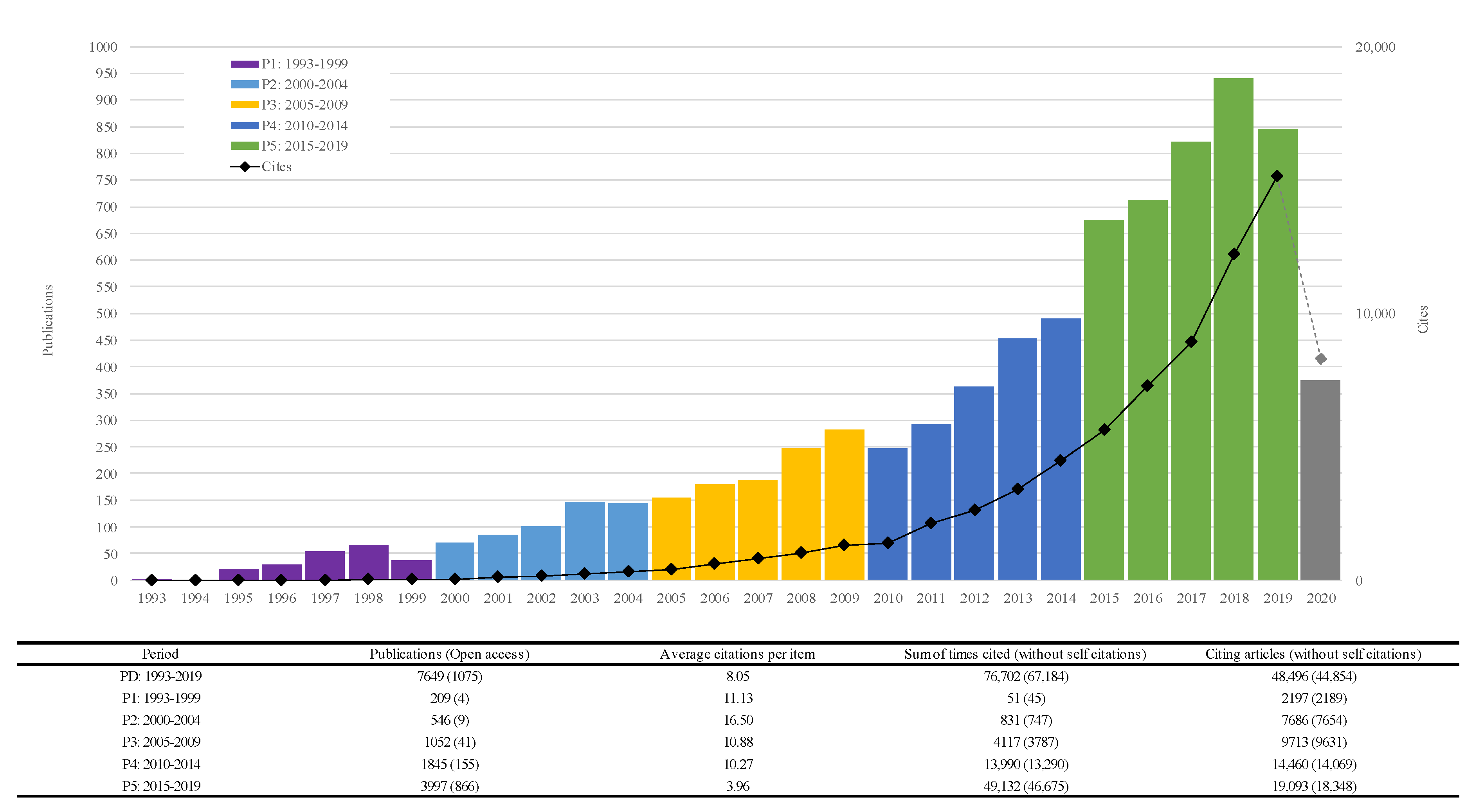
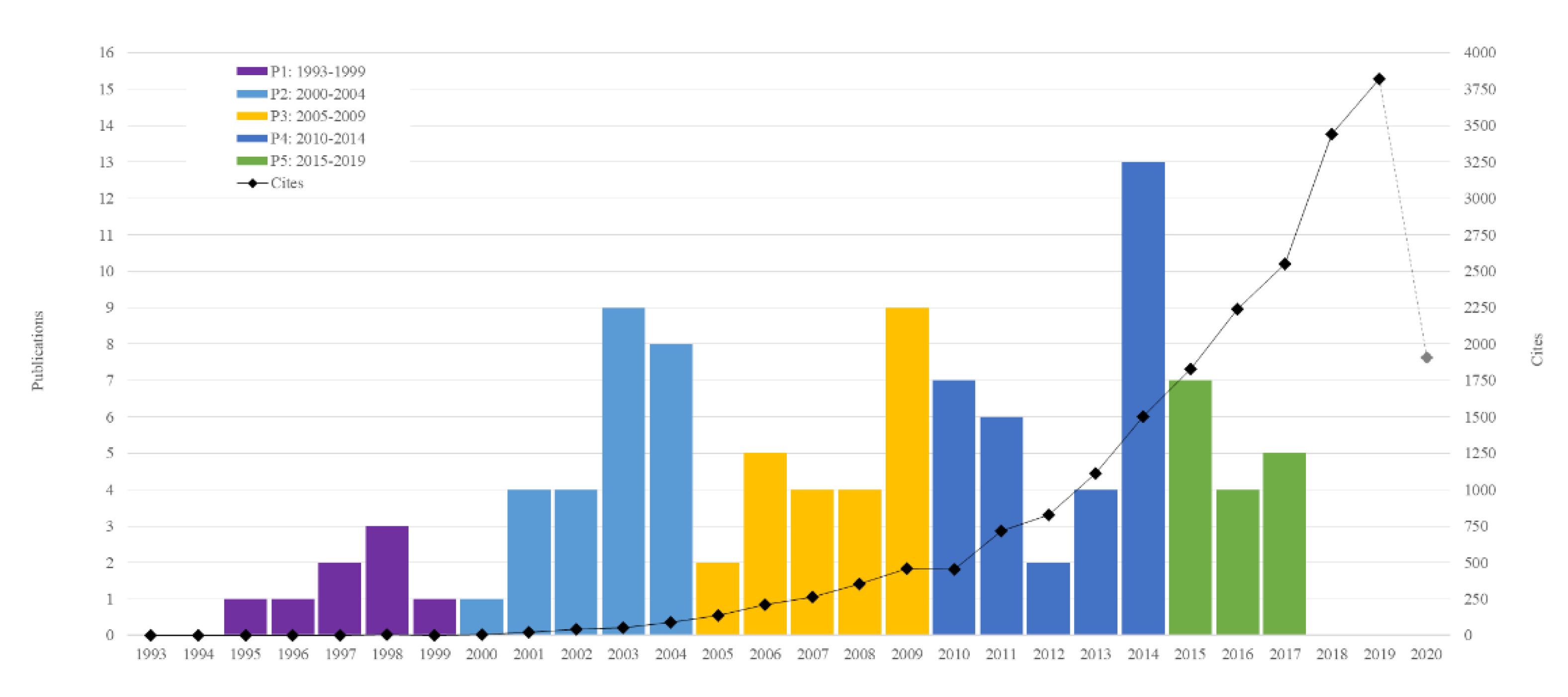
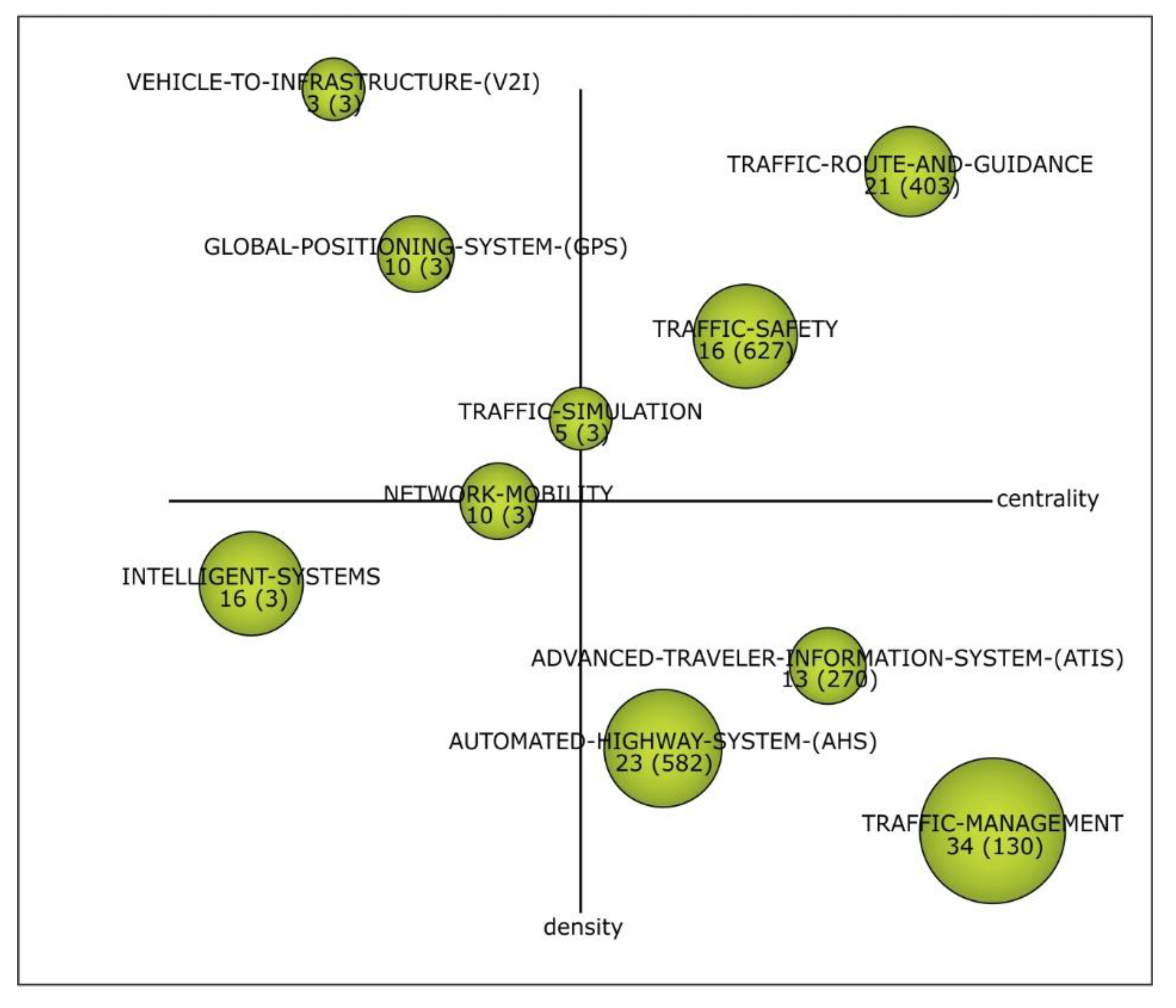
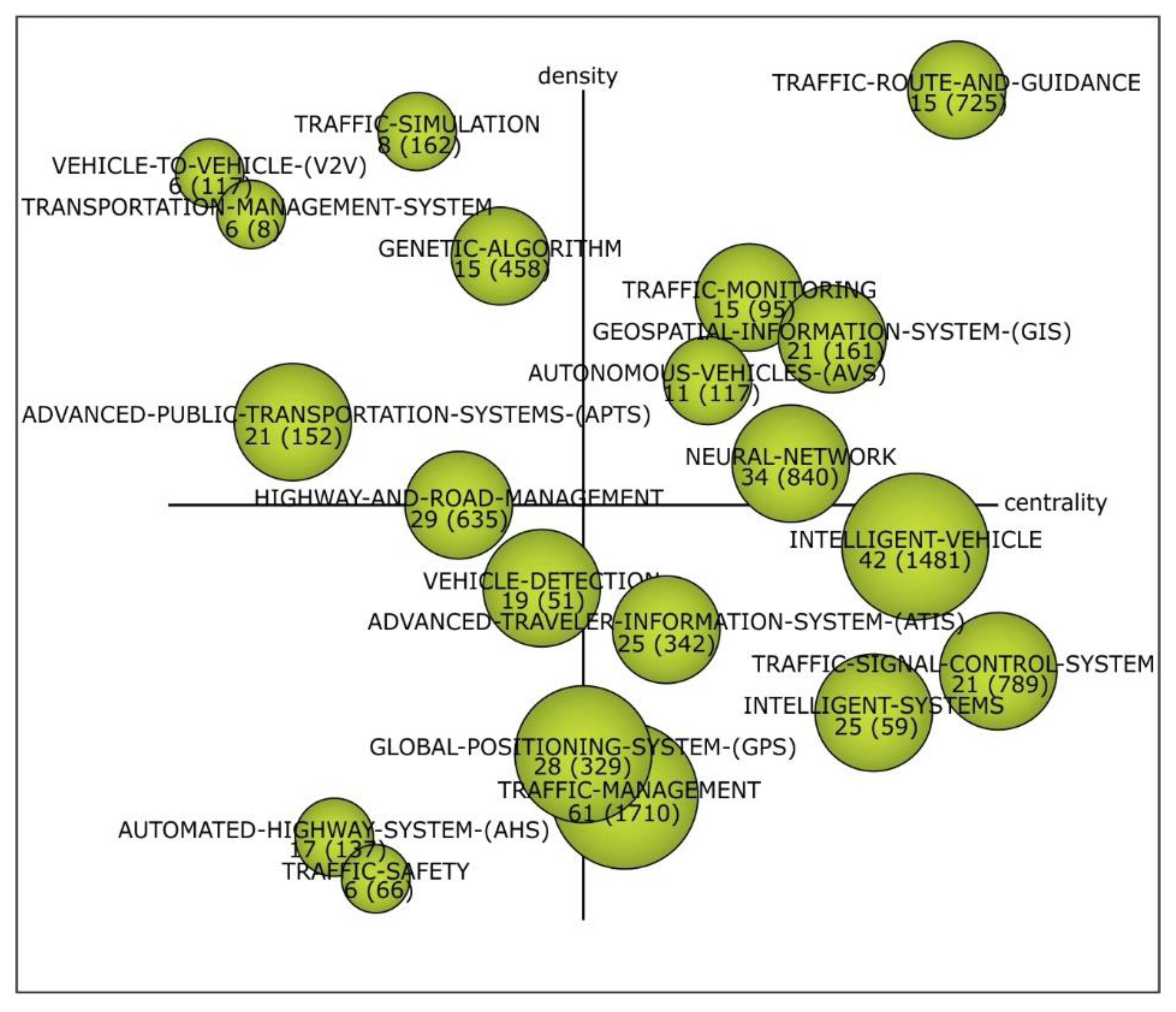
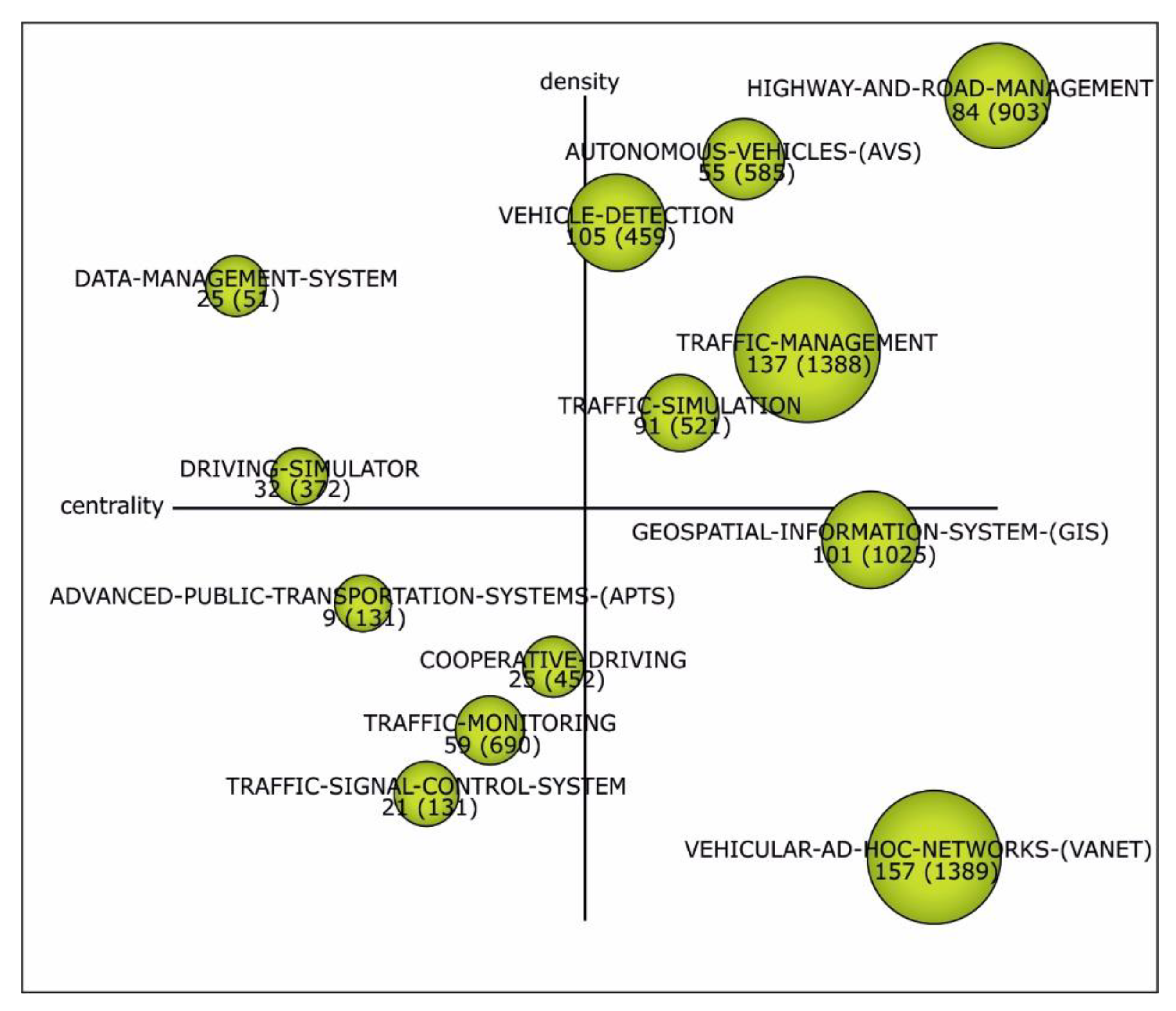
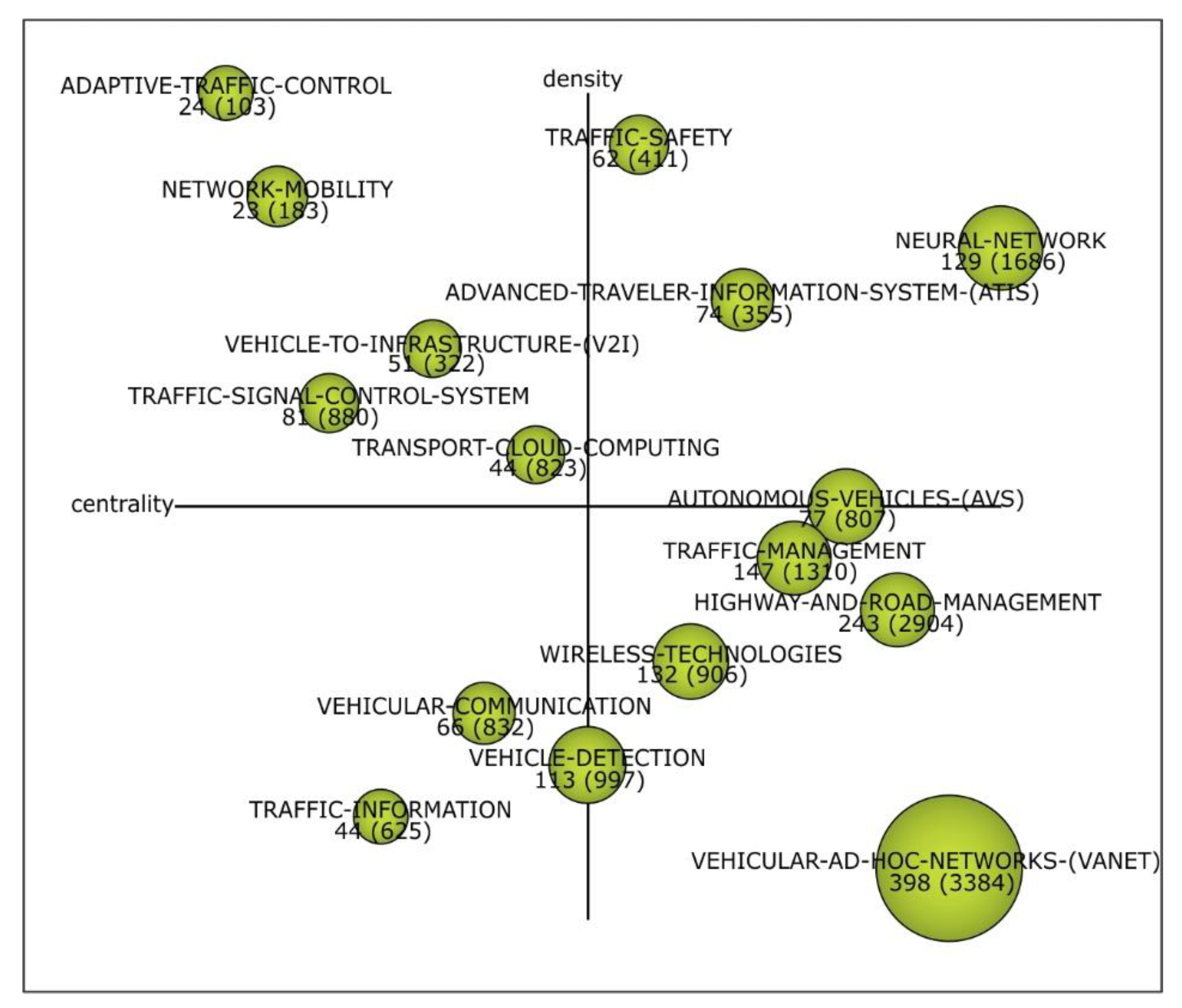
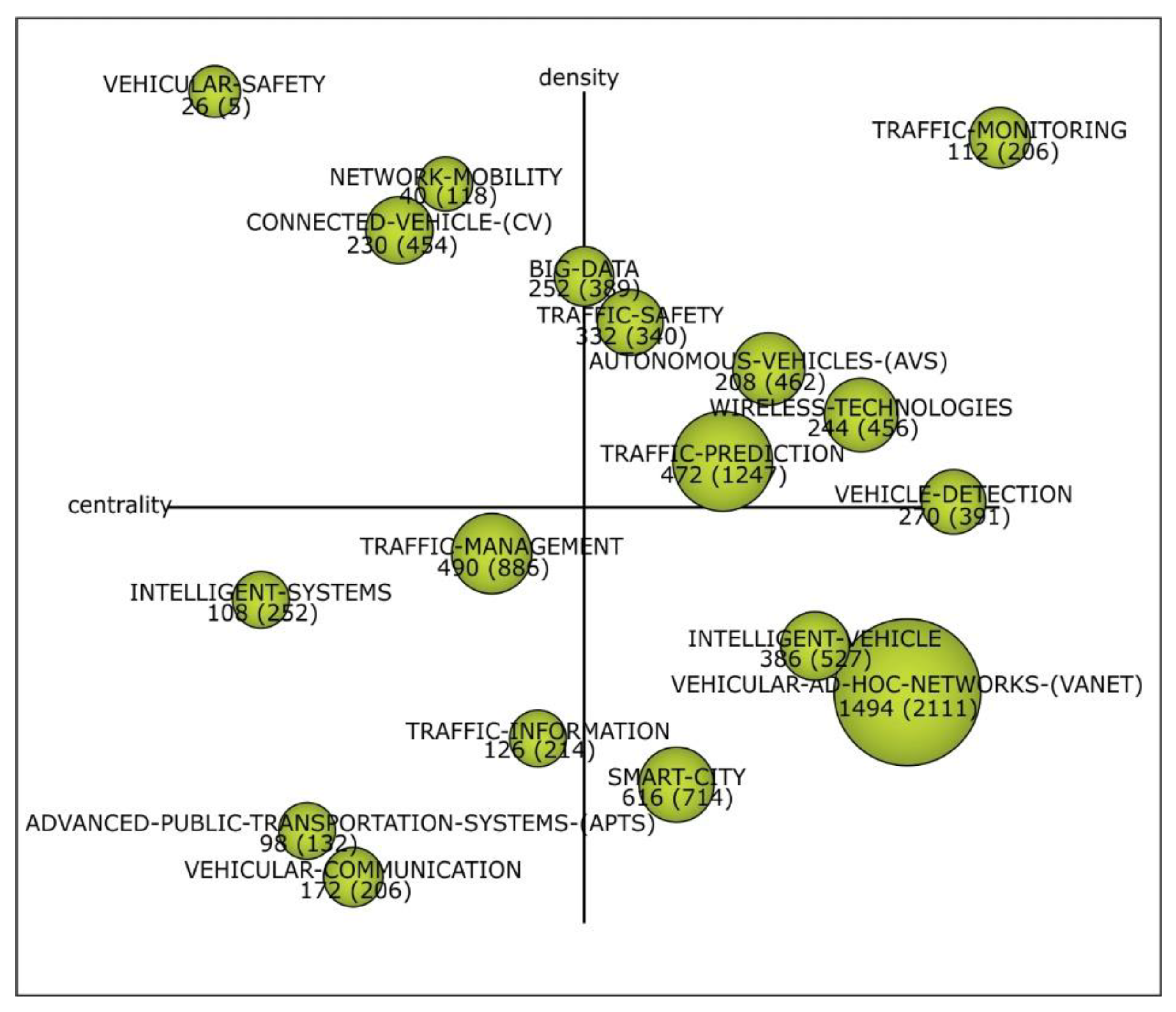
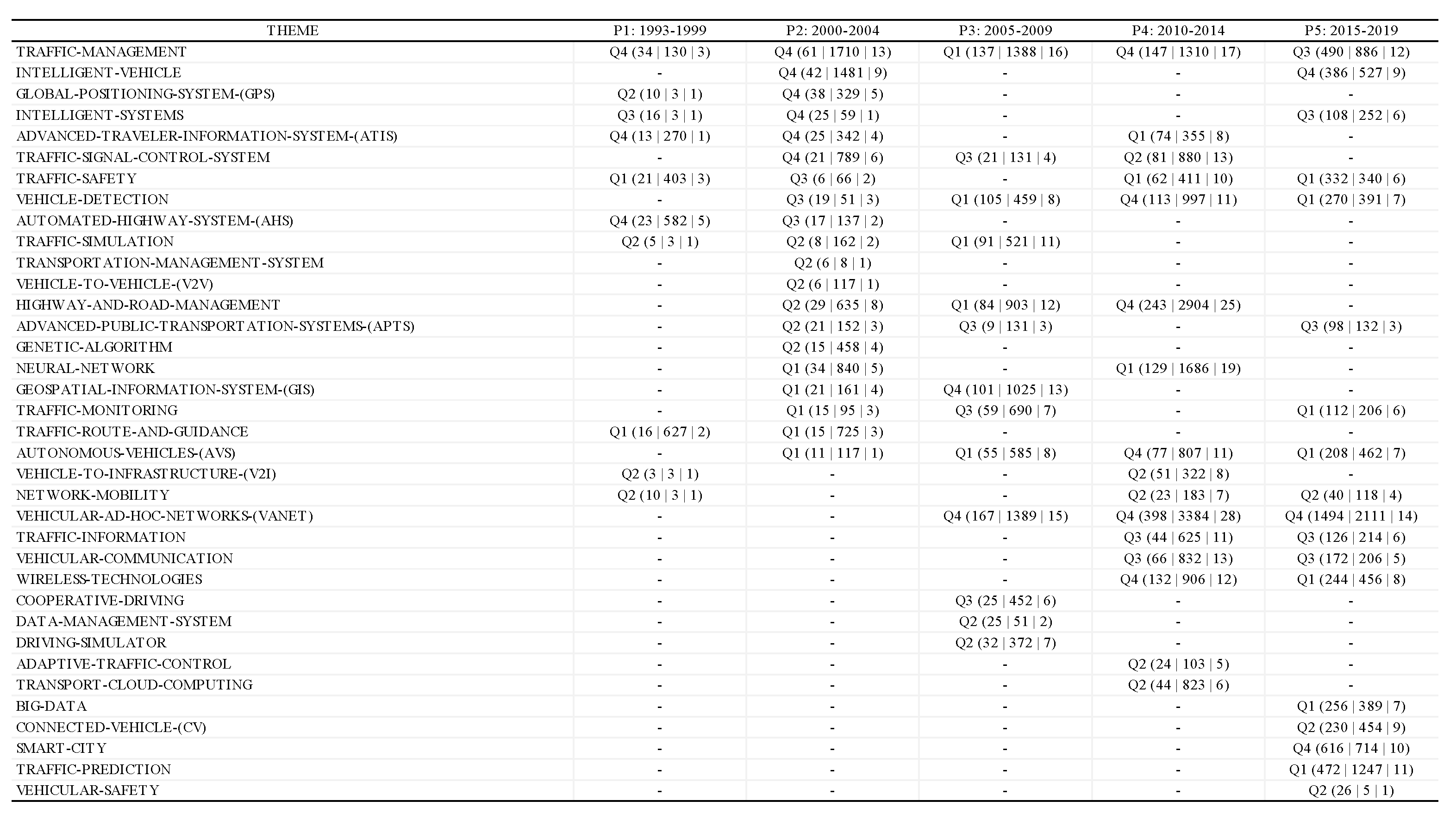
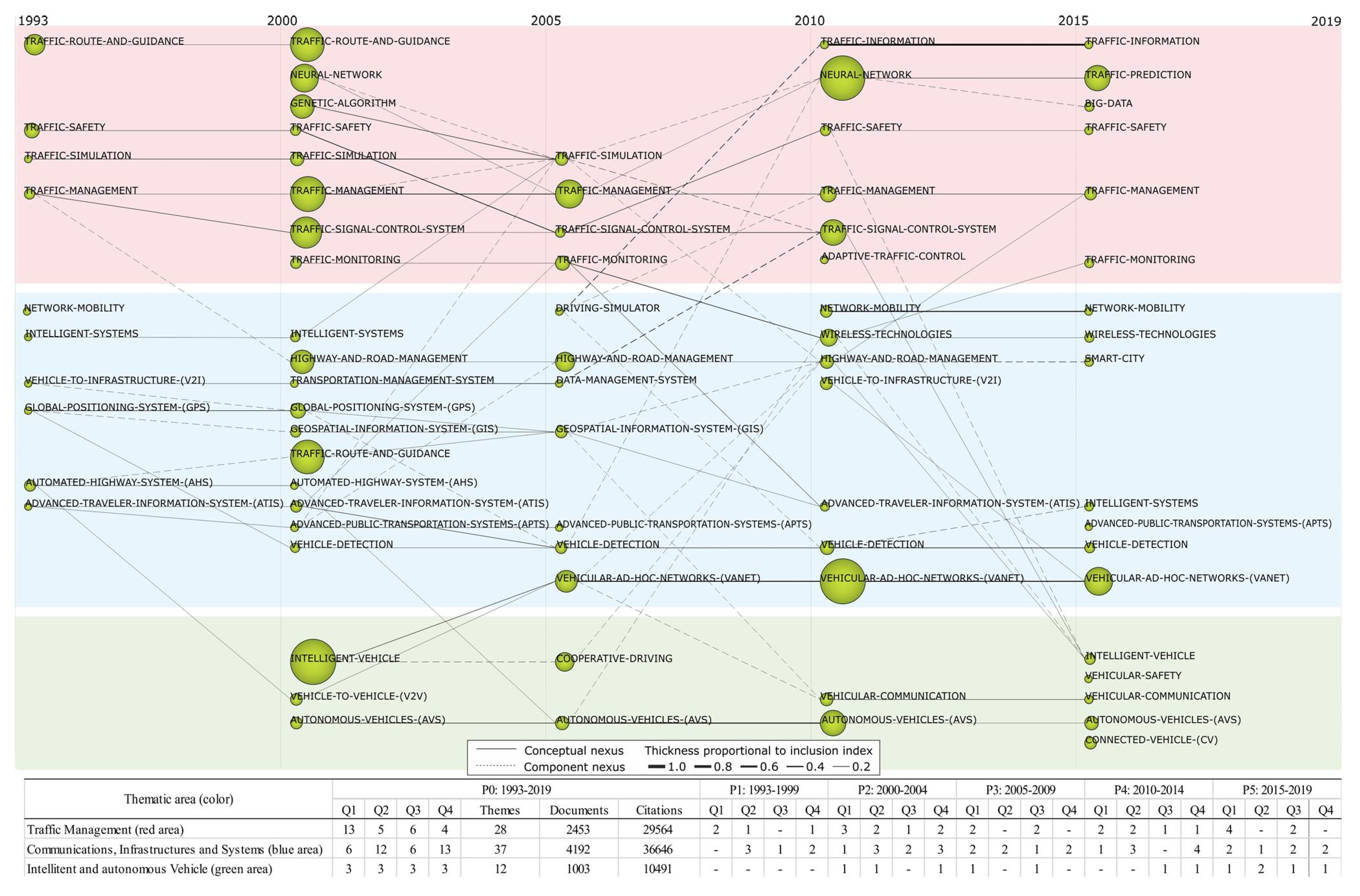
| Publications | Author(s) (Citations) | Citations | Author(s) (Publications) |
|---|---|---|---|
| 84 | Zhang, Y. (711) | 2458 | Wang, F. Y. (32) |
| 36 | Boukerche, A. (229) | 1260 | Karlaftis, M. G. (4) |
| 35 | Zhang, J. (188) | 1217 | Milanes, V. (31) |
| 34 | Li, X. (367) | 1038 | Vlahogianni, E. I. (10) |
| 33 | Onieva, E. (527); Zhang, L. (209) | 1012 | Lv, Y. S. (12) |
| 32 | Wang, F. Y. (2458) | 1003 | Golias, J. C. (5) |
| 31 | Milanes, V. (1217); Perez, J. (707); Wang, X. (304); Wang, Y. (51) | 978 | Li, Z. X. (8) |
| 30 | Wang, J. (133) | 890 | Chen, C. (29) |
| 29 | Chen, C. (890) | 887 | Duan, Y. J. (4) |
| 28 | Calafate, C. T. (405); Cano, J. C. (405); Li, Y. (145) | 855 | Kang, W. W. (4) |
| Publications | Author(s) (Cites) | Cites | Author(s) (Publications) |
|---|---|---|---|
| 5 | Wang, F. Y. (1913) | 1913 | Wang, F. Y. (5) |
| 4 | Karlaftis, M. G. (1260) | 1260 | Karlaftis, M. G. (4) |
| 3 | Adeli, H. (480); Golias, J. C. (985); Milanes, V. (648); Rilett, L. R. (422); Shladover, S. E. (616); Vlahogianni, E. I. (985); Williams, B. M. (764) | 985 | Golias, J. C. (3); Vlahogianni, E. I. (3) |
| 2 | Bertozzi, M. (371); Broggi, A. (371); Chabini, I. (222); Cheng, X. (413); Dia, H. (379); Fan, K. C. (253); Fascioli, A. (371); Jiang, X. M. (359); Li, L. (223); Trepanier, M. (522); Yan, G. J. (376); Yang, L. Q. (320); Zeadally, S. (227) | 826 | Duan, Y. J. (1); Kang, W. W. (1); Li, Z. X. (1); Lv, Y. S. (1) |
| 1 | 288 authors | >764-106 | 302 authors |
Publisher’s Note: MDPI stays neutral with regard to jurisdictional claims in published maps and institutional affiliations. |
© 2020 by the authors. Licensee MDPI, Basel, Switzerland. This article is an open access article distributed under the terms and conditions of the Creative Commons Attribution (CC BY) license (http://creativecommons.org/licenses/by/4.0/).
Share and Cite
Gamboa-Rosales, N.K.; Celaya-Padilla, J.M.; Hernandez-Gutierrez, A.L.; Moreno-Baez, A.; Galván-Tejada, C.E.; Galván-Tejada, J.I.; González-Fernández, E.; Gamboa-Rosales, H.; López-Robles, J.R. Visualizing the Intellectual Structure and Evolution of Intelligent Transportation Systems: A Systematic Analysis of Research Themes and Trends. Sustainability 2020, 12, 8759. https://doi.org/10.3390/su12218759
Gamboa-Rosales NK, Celaya-Padilla JM, Hernandez-Gutierrez AL, Moreno-Baez A, Galván-Tejada CE, Galván-Tejada JI, González-Fernández E, Gamboa-Rosales H, López-Robles JR. Visualizing the Intellectual Structure and Evolution of Intelligent Transportation Systems: A Systematic Analysis of Research Themes and Trends. Sustainability. 2020; 12(21):8759. https://doi.org/10.3390/su12218759
Chicago/Turabian StyleGamboa-Rosales, Nadia Karina, José María Celaya-Padilla, Ana Luisa Hernandez-Gutierrez, Arturo Moreno-Baez, Carlos E. Galván-Tejada, Jorge I. Galván-Tejada, Edgar González-Fernández, Hamurabi Gamboa-Rosales, and José Ricardo López-Robles. 2020. "Visualizing the Intellectual Structure and Evolution of Intelligent Transportation Systems: A Systematic Analysis of Research Themes and Trends" Sustainability 12, no. 21: 8759. https://doi.org/10.3390/su12218759
APA StyleGamboa-Rosales, N. K., Celaya-Padilla, J. M., Hernandez-Gutierrez, A. L., Moreno-Baez, A., Galván-Tejada, C. E., Galván-Tejada, J. I., González-Fernández, E., Gamboa-Rosales, H., & López-Robles, J. R. (2020). Visualizing the Intellectual Structure and Evolution of Intelligent Transportation Systems: A Systematic Analysis of Research Themes and Trends. Sustainability, 12(21), 8759. https://doi.org/10.3390/su12218759






